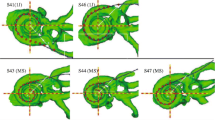Abstract
We have recently developed an implantable piezoelectric hearing aid transducer that is suitable for implantation in patients with sensorineural hearing loss. The transducer does not transmit sound but conducts micromechanical vibrations to the cochlea. In ten cat ears we investigated the efficiency of the implantable transducer with respect to the direct transfer of vibrations within the audible frequency range via the ossicles to the cochlea or directly into the vestibule. The acoustically evoked brainstem potential (ABR) threshold was determined prior to implantation, and the middle ear was then opened and the piezoelectric transducer coupled to the ossicles or to the perilymph. Acoustically evoked brainstem potentials were recorded following stimulation at the umbo, long process of the incus, stapes head, stapes foot plate, and in the vestibulum. Comparisons of the acoustically and mechanically evoked thresholds revealed a good correlation of the two stimulation levels. An electrical transducer voltage of 1 VRMS produced equivalent sound pressure levels (SPL) of 100–128 dB at the tympanic membrane. To assess the hearing we compared stimulus-dependent latencies of the early potentials (peaks P1–P5) and thresholds. This evaluation was based on four ears with normal hearing in which the piezoelectric transducer was coupled to the long process of the incus. The mean values of the latencies and their scattering range correlated extremely well in the two stimulation modes. They were nearly identical when the equivalent SPL of 100 dB was assigned to the maximally applied electrical level of 0 dB. These in vitro and in vivo findings demonstrate that the characteristics of the transducer warrant its development further from the prototype stage to become a component of an implantable hearing device for patients with sensorineural hearing loss.
Similar content being viewed by others
Author information
Authors and Affiliations
Additional information
Received: 14 June 1999 / Accepted: 30 September 1999
Rights and permissions
About this article
Cite this article
Plinkert, P., Baumann, J., Lenarz, T. et al. In vivo experiments in the cat with an implantable piezoelectric hearing aid transducer. European Archives of Oto-Rhino-Laryngology 257, 304–313 (2000). https://doi.org/10.1007/s004059900209
Issue Date:
DOI: https://doi.org/10.1007/s004059900209




